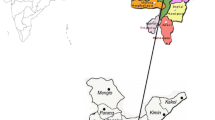Summary
Based on the study of 45 years (1948–1992) data, the average lowest MSL pressure of heat low over central Pakistan and adjoining northwest India of the month of May is found to have potential as a parameter for predicting all India Summer monsoon seasonal rainfall. This new parameter is seen to have stable and significant correlation with monsoon rainfall. Its correlation coefficients for different periods are found significant at 0.1% to 1% level of significance. The stability of the correlation coefficients was tested using 10, 20 and 30 year sliding windows. This test revealed that it is the most dependable parameter in comparison with 7 of the well known parameters analysed in this study. Regression models have been developed considering this new parameter along with other circulation parameters. The regression models developed are seen to perform very well for the independent data. The Root Mean Square Error (RMSE) values of some of these models, for independent data, are smaller than those of similar regression models reported in literature.
Similar content being viewed by others
References
Banerji, A. K., Sen, P. N., Raman, C. R. V., 1978: On foreshadowing southwest monsoon rainfall over India with midtropospheric circulation anomaly of April.Ind. J. Met. Hydrol. Geophys.,29, 425–431.
Elliot, W. P., Angell, J. K., 1987: The relation between Indian monsoon rainfall, the southern oscillation and hemispheric air and sea temperature 1884–1984.J. Climate Appl. Meteor.,26, 943–948.
Elliot, W. P., Angell, J. K., 1988: Evidence for changes in southern oscillation relationships during the last 100 years.J. Climate,1, 729–737.
Fu, C., Fletcher, J., 1988: Large signals of climatic variations over the ocean in the Asian monsoon region.Adv. Atmos. Sci.,5, 389–404.
Gowariker, V., Thapliyal, V., Kulshrestha, S. M., Mandal, G. S., Sen Roy, N., Sikka, D. R., 1991: A power regression model for long range forecast of southwest monsoon rainfall over India.Mausam,42, 125–130.
Hastenrath, S., 1987: On the prediction of Indian monsoon rainfall anomalies.J. Climate Appl. Meteor.,26, 847–857.
Hastenrath, S., Greischar, L., 1993: Changing predictability of Indian monsoon rainfall anomalies?Proc. Ind. Acad. Sci. (Earth and Planetary Sciences),102(1), 35–47.
Jagannathan, P., 1960: Seasonal forecasting in India — A review, India Meteorological Department, Pune, India, DGO82/650, 67 pp.
Jones, P. D., Raper, S. C. B., Bradley, R. S., Diaz, H. F., Kelly, P. M., Wigley, T. M. L., 1986: Northern hemisphere surface air temperature variations: 1851–1984.J. Climate Appl. Meteor.,25, 161–179.
Normand, C. W. B., 1953: Monsoon seasonal forecasting.Quart. J. Roy. Meteor. Soc.,79, 463–473.
Parthasarathy, B., Diaz, H. F., Eischeld, J. K., 1988: Prediction of all India summer monsoon rainfall with regional and large scale parameters.J. Geophys. Res.,93, (D5), 5341–5350.
Parthasarathy, B., Rupa Kumar, K., Sontakke, N. A., 1990: Surface and Upper air temperatures over India in relation to monsoon rainfall.J. Theor. Appl. Climatol.,42, 93–110.
Parthasarathy, B., Rupa Kumar, K., Munot, A. A., 1991: Evidence of secular variations in Indian monsoon rainfall — circulation relationships.J. Climate,4, 927–938.
Parthasarathy, B., Rupa Kumar, K., Munot, A. A., 1993: Homogeneous Indian monsoon rainfall: Variability and Prediction.Proc. Ind. Acad. Sci. (Earth and Planetary Sciences),102(1), 121–155.
Rao, K. N., 1965: Seasonal forecasting-India WMO Technical Note No. 66 WMO No. 162-TP-79, 17–30.
Rao, Y. P., 1976: Southwest Monsoon, Meteorological Monograph, No. 1, India Meteorological Department, 2 pp.
Shukla, J., Mooley, D. A., 1987: Empirical prediction of the summer monsoon rainfall over India.Mon. Wea. Rev.,115, 695–703.
Sundar, R. S., 1990: Indian monsoon rainfall in relation to surface pressure anomalies.Mausam,41, 487–489.
Thapliyal, V., 1987: Prediction of Indian monsoon variability evaluation and prospects including development of a new model. In: Ye, D., Fu, C., Chao, J., Yoshino, J. (eds.)Climate of China and Global Climate. Beijing: China Ocean Press, 397–416.
Thapliyal, V., 1990: Large scale prediction of summer monsoon rainfall over India: Evolution and development of new models.Mausam,41, 339–346.
Walker, G. T., 1908: Correlation in seasonal variation of Climate (Introduction).Mem. India Met. Dep.,20, Part VI, 117–124.
Walker, G. T., 1910: Correlation in seasonal variations of Weather II.Mem. India Met. Dep., XXI, XXII.
Author information
Authors and Affiliations
Additional information
With 8 Figures
Rights and permissions
About this article
Cite this article
Singh, D., Bhadram, C.V.V. & Mandal, G.S. New regression model for Indian summer monsoon rainfall. Meteorl. Atmos. Phys. 55, 77–86 (1995). https://doi.org/10.1007/BF01029603
Received:
Revised:
Issue Date:
DOI: https://doi.org/10.1007/BF01029603




